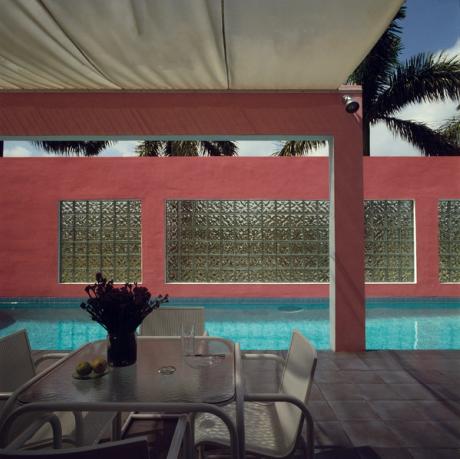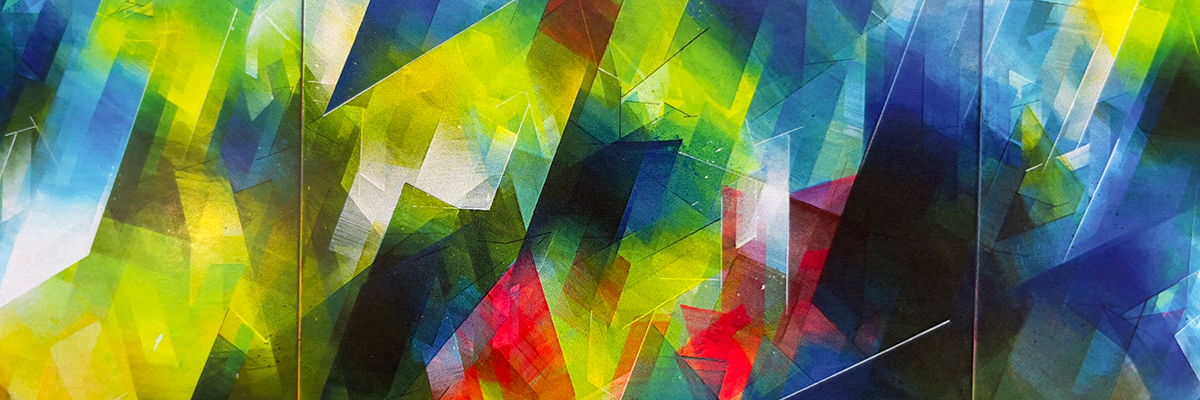Carib Carnival
1972 - Painting (Painting)
70.5 x 121 cm
Aubrey Williams
Carib Carnival illustrates Aubrey Willams’s unique artistic language, combining Pre-Columbian iconography with abstraction. A series of abstracted shapes that resemble bones, masks and serpent-like images surrounded by fiery vapors and gases, illustrate the destruction of culture as one of the predominant themes of Williams’s work. He considered the Mayan and Aztec cultures to exemplify a number of present-day faults; according to Williams they developed technologies that would eventually lead to their own destruction. Williams melds a combination of Gorky and German Expressionsim with his West African heritage, painting what he characterized as “the smell of old blood … the smell of the presence of the conquistadors. It’s the smell of loss, and replacement with lesser than what was destroyed. It’s equality coming out of forced change, a displacement of identity, violation and yet new growth asserting itself.” Williams’s work thus looks at the world from a Guyanese perspective with a strong sense of his African heritage, as well as the destructiveness of European culture. Carib Carnival , while perhaps celebrating the frenzy of carnival, brings to the fore the idea of destruction of civilizations, the destruction by civilizations and an African holocaust. It is a bonfire of civilizations out of which something might rise. There is another image hidden within the work, a bound, reclining figure, perhaps a reference to the rapacious behavior of imperial colonizers and the auto-da-fé. Painted the year of Carifesta , the first Pan-African Festival of the Arts that involved Williams, and that of the end of the Caribbean Artists Movement as a group, Carib Carnival invokes the timeline of a gathering for cultural recognition and independent creativity.
Aubrey Williams was one of the founding members of the Caribbean Artists Movement, formed in the 1960s in the United Kingdom, after settling there in the early 1950s. Brought up in Guyana, he attended the Working People’s Art Class (WPAC), the first official art institution in the country. As a trained agronomist, Williams worked in the field with the Warrau tribe during British colonization. The experience of living in the jungle with the Warrau deeply impacted his artistic vocabulary. Arriving in London in 1952 as part of the Windrush generation, Williams went to St Martin’s School of Art and was exposed to the German Expressionists at Marlborough Gallery and the Abstract Expressionists at the Tate and Whitechapel Galleries. While his early exhibitions were greeted with interest, he was soon marginalized by critics and art historians. It was only in 1989, when a series of his works were shown as part of the exhibition The Other Story at the Hayward Gallery that he and his fellow black artists emerged from the shadows of a discriminatory history. Williams is now regarded as one of the most important British artists of his generation. His paintings resonate with his own culture while also engaging with the Western gaze and its terminology of modernism.
Colors:
Related works sharing similar palette

© » ARTS EQUATOR
Veteran Artists Team Up with Younger Generation at ‘Wild Eye’ Exhibition (via The Irrawady) | ArtsEquator Thinking and Talking about Arts and Culture in Southeast Asia Articles September 12, 2018 YANGON — Veteran modernists and younger generations have teamed up to exhibit their works together in Yangon...

© » SLASH PARIS
Kim Tschang-Yeul — Disparitions — Almine Rech Gallery, Matignon — Exhibition — Slash Paris Login Newsletter Twitter Facebook Kim Tschang-Yeul — Disparitions — Almine Rech Gallery, Matignon — Exhibition — Slash Paris English Français Home Events Artists Venues Magazine Videos Back Kim Tschang-Yeul — Disparitions Exhibition Painting Vue de l’exposition Kim Tschang-Yeul, Disparitions à la galerie Almine Rech, Paris Courtesy of the artist & Galerie Almine Rech, Paris Kim Tschang-Yeul Disparitions Ends in 11 days: November 18 → December 22, 2023 It was twilight when Kim Tschang-Yeul, then aged 42, discovered the droplet while sprinkling water over one of his canvases...

© » DAZED DIGITAL
Texas Hold ‘Em: Beyoncé drops two country-tinged singles | Dazed â¬…ï¸ Left Arrow *ï¸âƒ£ Asterisk â Star Option Sliders âœ‰ï¸ Mail Exit Music News The singer announces the second stage of her Renaissance trilogy, and releases a duo of new tracks 12 February 2024 Text Dazed Digital During the Superbowl last night, Beyoncé announced that her new album – Act II – will be released on March 29...

© » KADIST
Li Binyuan
2014Freedom Farming presents how, after being given the right of farming, Li Binyuan began to re-dig his land...

© » SLASH PARIS
Georges Rousse — Couleurs — Catherine Putman Gallery — Exhibition — Slash Paris Login Newsletter Twitter Facebook Georges Rousse — Couleurs — Catherine Putman Gallery — Exhibition — Slash Paris English Français Home Events Artists Venues Magazine Videos Back Georges Rousse — Couleurs Exhibition Photography Georges Rousse, Bilbao, 2023 Impression jet d’encre sur hahnemühle — 145 × 115 cm © D...

© » THEARTNEWSPER
Miami Advice: Nina Johnson on the Spear House of North Bayshore Drive Art market Museums & heritage Exhibitions Books Podcasts Columns Technology Adventures with Van Gogh Search Search Art Basel in Miami Beach 2023 interview Miami Advice: Nina Johnson on the Spear House of North Bayshore Drive The gallerist says that the pretty-in-pink property exudes the quintessential 1980s South Florida vibe that still resonates today Tim Schneider 7 December 2023 Share Laurinda Spear’s original plan, created with Rem Koolhaas, was rejected by the client: her parents Photo: Elizabeth Whiting Located at 9325 North Bayshore Drive, in the Miami Shores neighbourhood, the Spear House (aka the Pink House) looms large in the cultural imagination of South Florida...

© » ARTS EQUATOR
Reflections on Art, Angin, Sickness and The Soul of Malaysia | ArtsEquator Thinking and Talking about Arts and Culture in Southeast Asia Articles Wong Horngyih, courtesy of Pusaka April 30, 2020 By Jo Kukathas (5,500 words, 15-minute read) The news that Germany rolled out a 50 billion bail-out for the arts during the Coronavirus pandemic made headlines worldwide the week it was announced...

© » KADIST
Joe Scanlan
2007Spring Line is a piece shown for the first time in his solo exhibition at the Institut d’Art Contemporain in Villeurbanne in 2007...

© » AMERICANSFORTHEARTS
Update on Americans for the Arts Events in 2023 | Americans for the Arts Jump to Main Content Americans for the Arts Arts Action Fund National Arts Marketing Project pARTnership Movement Animating Democracy Facebook Twitter LinkedIn Instagram YouTube Load Picture Home News Room Update on Americans for the Arts Events in 2023 Hello Guest | Login Update on Americans for the Arts Events in 2023 Thursday, February 16, 2023 It is an exciting time at Americans for the Arts, full of change and new energy...

© » HYPERALLERGIC
Zara Stores Face Protests Over Ads Evoking Palestinian Suffering Skip to content @freedomcats_ #zara #fyp #protest #news ♬ Running Up That Hill (A Deal With God) [2018 Remaster] – Kate Bush Groups of demonstrators staged walk-in protests in Zara stores in Hannover, Germany, and Melbourne, Australia, this past week in response to a recent ad campaign by the fast-fashion brand that critics said appropriated images of Palestinian death and suffering...

© » LENS CULTURE
In Pieces - Photographs by Sophia Bulgakova, Lia Dostlieva, Ola Lanko, Katia Motyleva and Kateryna Snizhko | Book review by Sophie Wright | LensCulture Feature In Pieces In this imaginative collection of photobooks “made with a child in mind,” five artists of Ukrainian descent explore the everyday heroism of life in wartime...

© » ARTS EQUATOR
Exploring The End Of The Golden Era Of Singapore Cinema Thinking and Talking about Arts and Culture in Southeast Asia Film February 24, 2022 By ArtsEquator (1,001 words, 3-minute read) Films as a medium and art form have always possessed great potential to convey crucial messages and influence the cultural zeitgeist of their times...

© » KADIST
Joana Hadjithomas & Khalil Joreige
2017Produced for the Prix Marcel Duchamp and presented at the Centre Pompidou in October 2017, the installation Uncomformities is comprised of photographs, archaeological drawings, and narratives, based on the analysis of core samples from different sites in Beirut, Paris and Athens...







